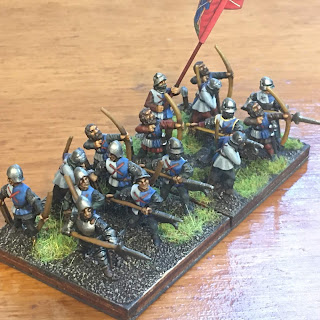Cold rainy Sunday morning and I have a bench full of 15mm ( mostly
Essex) spread before me on the painting table. Its been a little over 30
years since I started adding 15mm models to my miniatures armies (
25/28mm being my first love scale wise). I started with Essex which to
many was considered state of the art at the time ( and when compared to
makers like Minifigs it is so very easy to see why). Fast forward 30
years. Many new brands many more eras supported and Essex is still there
and its still really really good ( mostly).
As
far as crispness and consistency as well as just sheer range of
offerings, no one has yet found a way to surpass them, however, I have
found a few things that are peculiar to Essex. We can call it the
miniatures equivalent to " Barkerese", which is appropriate to me
because I cannot think about a WRG product without thinking about
pouring over piles of Essex miniatures. So a couple of things I can't
quite get past with Essex 15s ( I collect a few of their ancient ranges
but almost all my experience is with their Dark Age, Medieval and Early
Renaissance offerings).
The poses: Static, yes, but just as often animated in simply the strangest positions.
Facial
hair: (What?! you say?) Yeah I get the definite impression that the
sculptors ( and by the way do we know the sculptors by name? If not I
wonder why not?!) got all their reference work from looking at Victorian and
Edwardian age illustrations of medieval dress. Regardless of period it
seems like mustaches and shag haircuts are the all the rage.
occasionally a beard but the prevalence of mustaches is such a hoot
because there are definitely periods ( like most of the 15th Century)
where facial hair was not in vogue in the West.
Whitman Samplers: Anyone whose been collecting DBA armies for a while will learn pretty quicky that it is a much better value to purchase prepackaged DBA armies rather than trying to piece an army together one small baggy at a time. I even will buy entire armies just for the discounted price per mini. Many mini companies seem to be offering starter armies packaged for DBA now but Essex is definitely the grandaddy of 'army in a bag' packaging and as far as I can tell there isn't a single company that offers the breadth of complete DBA armies that Essex does. There is a trade off though. Being prepackaged, the modeler does not get to choose what goes into the bag and sometimes ( no most of the time actually) there will be troops that are super generic of just don't fit the period I'm trying to represent. So its off to the mini archive for those models and back to sifting for the right models in those instance.
Still, the positives far outweigh the drawbacks. I've even noticed as I've begun buying 15's again that Essex has some more up-to-date sculpts. The newer poses I have stumbled upon ( I am actually presuming these are relatively new at least) are much more interestingly posed and seem to be more attentive to correct period dress and harness.Certain manufacturers have made a niche for themselves focusing upon specific armies and periods. Some these manufacturers excel at capturing the flavor of their subject matter more easily than Essex might, out of the box. ( I really like Corvus Belli for example, when working on my middle period HYW English and French.) Still, as I sift through my latest Essex purchases this weekend I am astounded at the enduring quality of a product line the virtually reached back to my childhood years of gaming. No small feat, I say, in an age where change and "innovations" can be measured in days and months rather than years. I think I'll close out this post with a few comparison shots of different ranges compared to Essex. I've tried to show some of the newer Essex models just to emphasize their range at its best.
Picture I snapped for a friend shopping for his first DBA army. Baueda Vikings ( left) vs Essex Vikings (right)
Baueda Anglo-Norman (left) vs Essex Anglo-Norman (right)
Medus Medieval Low Countries (left) vs Essex Medieval Low Countries (right)
Later Swiss
Left to right: Mirliton, Old Glory (Blue Moon Manufacturing), Legio Heroica, and Essex
Medieval hipsters! ( mustaches for everybody!)
New or old, Essex is really satisfying to paint and can provide a solid foundation for very satisfying and authentic looking 15mm army.























